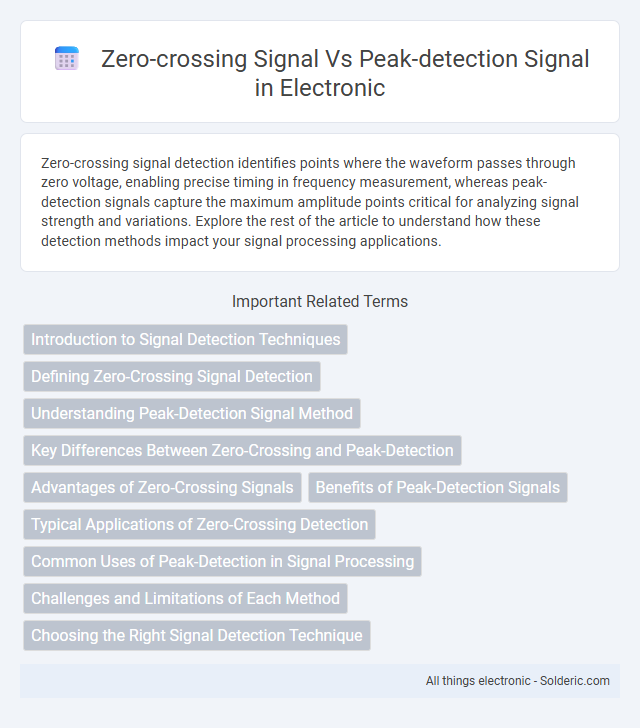Zero-crossing signal detection identifies points where the waveform passes through zero voltage, enabling precise timing in frequency measurement, whereas peak-detection signals capture the maximum amplitude points critical for analyzing signal strength and variations. Explore the rest of the article to understand how these detection methods impact your signal processing applications.
Comparison Table
| Feature | Zero-Crossing Signal | Peak-Detection Signal |
|---|---|---|
| Definition | Detects points where signal crosses zero amplitude. | Identifies local maxima or minima (signal peaks). |
| Purpose | Measures frequency and timing. | Measures signal amplitude and event occurrence. |
| Signal Type | Effective for periodic waveforms. | Applicable to both periodic and non-periodic signals. |
| Noise Sensitivity | Moderately sensitive; noise can cause false zero crossings. | Higher sensitivity; noise can create false peaks. |
| Complexity | Simple implementation. | Moderate to complex, requires peak validation. |
| Output | Timing of zero-cross events. | Amplitude and timing of peaks. |
| Applications | Frequency counters, phase-locked loops, digital signal processing. | Event detection, envelope detection, biomedical signal analysis. |
Introduction to Signal Detection Techniques
Zero-crossing signal detection identifies the points where the signal waveform crosses the zero voltage level, providing precise timing information critical for frequency and phase analysis. Peak-detection signal focuses on capturing the maximum amplitude points within the waveform, which is essential for amplitude measurement and envelope detection in audio and communication systems. Understanding these fundamental techniques allows you to choose the appropriate method based on your signal characteristics and analysis requirements.
Defining Zero-Crossing Signal Detection
Zero-crossing signal detection identifies points where a waveform crosses its baseline, changing from positive to negative or vice versa, essential for frequency and phase analysis in signal processing. This method provides precise timing information, enabling applications like speech processing, vibration analysis, and pitch detection. Compared to peak-detection, zero-crossing detection offers simpler implementation and faster computation but may be less effective in noisy environments.
Understanding Peak-Detection Signal Method
Peak-detection signal method identifies the maximum amplitude points within a waveform, enabling precise measurement of signal peaks crucial for applications like vibration analysis and audio processing. This technique captures transient events more accurately than zero-crossing methods by focusing on signal magnitude rather than zero level crossings, improving reliability in noisy environments. Peak detection improves feature extraction in spectral analysis, enhancing performance in fault diagnosis, communication systems, and biomedical signal monitoring.
Key Differences Between Zero-Crossing and Peak-Detection
Zero-crossing signals identify points where the waveform crosses the zero voltage level, commonly used for timing and frequency measurement, while peak-detection signals pinpoint maximum or minimum amplitude values, essential for envelope detection and amplitude analysis. Zero-crossing methods offer simplicity and robustness against amplitude variations but can be prone to noise-induced errors, whereas peak detection provides precise amplitude information but requires more complex circuitry and is sensitive to signal distortion. Understanding these key differences helps optimize signal processing strategies in applications like audio processing, communication systems, and control mechanisms.
Advantages of Zero-Crossing Signals
Zero-crossing signals offer precise timing information by detecting the exact moments when a waveform crosses the zero voltage level, reducing noise susceptibility compared to peak-detection signals. This approach enhances signal processing accuracy, especially in applications involving frequency measurement and phase-locked loops. Your system benefits from improved stability and reliability due to the consistent detection threshold inherent in zero-crossing methods.
Benefits of Peak-Detection Signals
Peak-detection signals provide more accurate representation of the signal's amplitude compared to zero-crossing signals, enabling precise measurement of peak values critical in applications like audio processing and vibration analysis. These signals reduce errors caused by noise near zero-crossings, improving overall signal quality and reliability. Your system benefits from enhanced signal clarity and better performance in dynamic environments when utilizing peak-detection methods.
Typical Applications of Zero-Crossing Detection
Zero-crossing detection is widely used in phase-locked loops, motor speed control, and frequency measurement due to its ability to accurately identify signal transitions through the zero voltage level. It plays a crucial role in digital signal processing for timing and synchronization tasks, particularly in audio processing and power electronics where detecting the exact point of waveform crossing improves efficiency and reduces noise. This method is favored in controlling AC power devices such as thyristors and triacs to minimize switching transients and optimize performance.
Common Uses of Peak-Detection in Signal Processing
Peak-detection signals are widely used in signal processing for accurately identifying local maxima in waveforms, critical for applications such as heartbeat monitoring, vibration analysis, and audio signal enhancement. Unlike zero-crossing methods that primarily detect frequency information, peak detection allows you to measure amplitude variations and transient events, enabling precise analysis of signal strength and dynamics. This technique is essential in fields like biomedical engineering and communications, where detecting peak values directly impacts performance and reliability.
Challenges and Limitations of Each Method
Zero-crossing signal detection faces challenges such as susceptibility to noise and signal distortion, which can lead to false triggering and inaccurate timing measurements. Peak-detection signals contend with difficulties in accurately identifying true peaks in the presence of fluctuating baselines or overlapping waveform components, often requiring complex filtering algorithms. Both methods have limitations in handling non-stationary signals and require careful calibration to minimize errors in real-world signal processing applications.
Choosing the Right Signal Detection Technique
Choosing the right signal detection technique depends on your application's requirements for accuracy and timing. Zero-crossing detection is ideal for identifying points where the signal changes polarity, providing precise timing information often used in phase-locked loops and timing circuits. In contrast, peak-detection signals excel in measuring signal amplitude, making them better suited for applications requiring peak value analysis, such as envelope detection or signal strength monitoring.
Zero-crossing signal vs peak-detection signal Infographic

 solderic.com
solderic.com